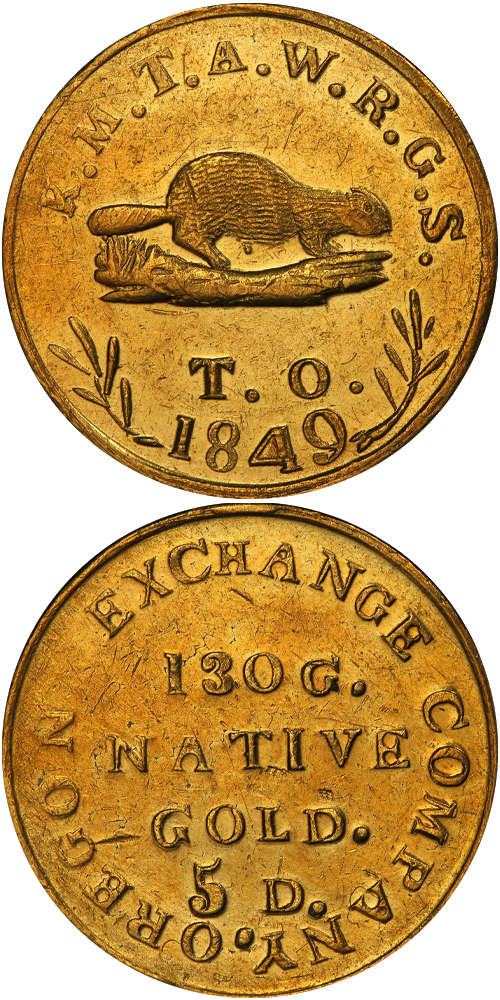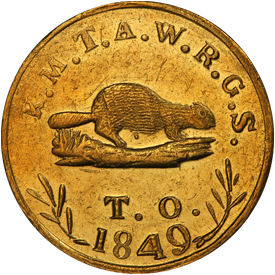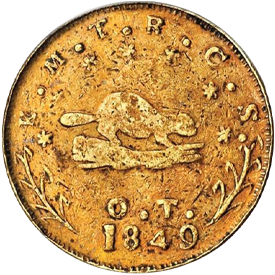Many Oregonians who traveled to California to seek their fortune in the gold fields returned home bringing with them quantities of nuggets and gold dust. As with their neighbors in California, local money was in short supply and use of gold dust as a medium of exchange was fraught with difficulties. To address this issue, the Oregon Exchange Company was established by several prominent Oregon City residents in early 1849.
Early in 1849 there had been a number of petitions to establish a mint in Oregon. On February 15, 1849 an act was passed by a vote of 16 to 2 in the Legislature which provided for the establishment of a territorial mint in Oregon City. It was also provided that any profits arising from the coinage would be used to pay the debt of the Cayuse Indian War.
The Treasurer was authorized to purchase gold dust of virgin purity at $16.50 per ounce. The coin should be lawful tender throughout the Territory at $1 per pennyweight. Punishment was provided for anyone who traded gold of false weight or who stamped gold without legal permission. The mint was to be established in Oregon City, an important village 15 miles distance from Portland. The act stipulated that:
The dies for stamping shall represent on one side the Roman figure 5 for the pieces of five pennyweights and the Roman figure 10 for the pieces of ten pennyweights. The reverse side shall have the words "Oregon Territory" and the date of the year of stamping around the face, with the arms of Oregon in the center.
Joseph Lane, the governor, declared the legislative act to be unconstitutional on March 3rd, for it seemed to be in conflict with United States government coinage laws. To remedy the situation a group of eight prominent merchants and citizens banded together to establish a private mint. The principals were W. K. Kilborne, Theophilus Magruder, James Taylor, George Abernathy, W. H. Wilson, William H. Rector, J. G. Campbell, and Noyes Smith. The firm was designated as the Oregon Exchange Co.
Hamilton Campbell, a Methodist missionary, was employed to cut dies for a $5 piece. Victor Wallace, machinist, engraved the dies for a coin of the $10 denomination. The coins produced were to be virgin gold without alloy.
The obverse die for the $5 gold bore the initials K.M.T.A.W.R.G.S., representing the names of the company members, Kilborn, Magruder, Taylor, Abernethy, Willson, Rector, Campbell, and Smith. The G was an error and should have been C for Campbell. The obverse of the $5 piece pictured a beaver on a log facing to the right, the same animal which, being a trademark of the Territory, had been used earlier on the Northwest Co. tokens. Below was the designation T.O. for Territory of Oregon, and below that the year 1849 with branches to each side. On the reverse appeared the notation OREGON EXCHANGE COMPANY, 130 G. NATIVE GOLD 5 D. The pieces contained 130 grains of gold, or nearly 5 1/2 pennyweight.
The $10 design was similar to the $5 except that the error of the G initial was corrected by substituting the correct letter C. The initials of Abernathy and Wilson were omitted, perhaps because they had left the firm by the time that the $10 issues were made. The abbreviation of Oregon Territory was changed to O.T. rather than the earlier T.O. With the exception of the denomination and weight information, the design closely followed that of the earlier $5. The dies were engraved very lightly on the reverse, with the result that coins struck were characteristically very weak on that side.
While no effort was made to standardize the alloy, the coiners compensated for this by deliberating making the coins overweight. U. S. Mint assays report that the five dollar coins were valued at $5.50. While this helped to guarantee their acceptance, being worth more than their stated value ensured that the pieces would be taken in at face and melted down for their intrinsic value.
Thomas Powell produced the necessary machinery for preparing the metal and striking the coin using as a source iron from wagon wheel rims. The Oregon Exchange Co. paid him $1 a pound for all the iron he was able to obtain for this purpose from old wagons that had crossed the plains and other sources. Powell did the forging, and William Rector, one of the partners in the Oregon Exchange Co., did the lathe work.
Coinage amounted to approximately 6,000 of the $5 pieces and 2,850 $10 coins before minting operations ceased in September 1849 when their two crucibles broke and the company decided to disband. These were accepted as legal tender throughout the Oregon Territory, which at that time included the present states of Oregon and Washington and all land toward the east reaching to the Rocky Mountains. Oregon City had approximately 1,000 white citizens, while the entire Territory comprised only about 9,000 inhabitants.
Many of the Oregon issues were sent to California in payment for merchandise. Eventually nearly all were melted. By a decade after the original issue only a small number of Oregon coins existed.








